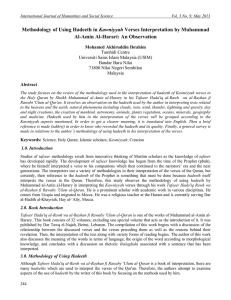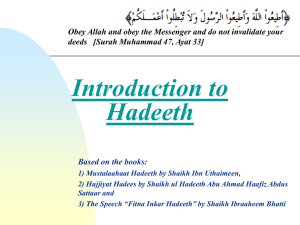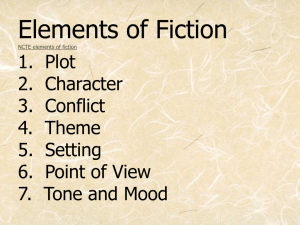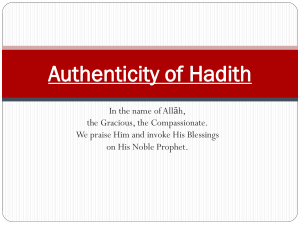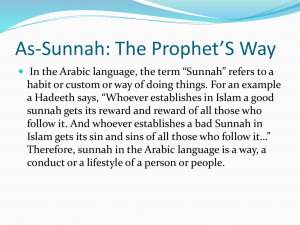The Basics of Uloom-ul-Hadeeth Grade 112
advertisement
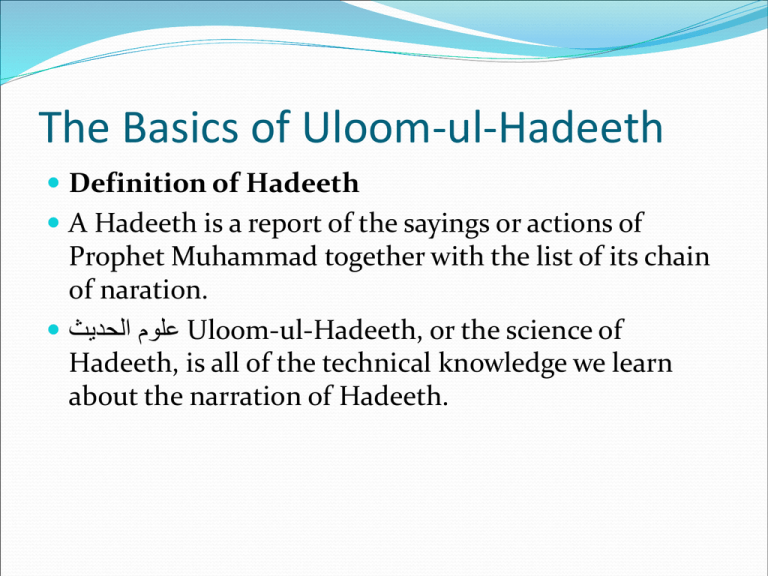
The Basics of Uloom-ul-Hadeeth Definition of Hadeeth A Hadeeth is a report of the sayings or actions of Prophet Muhammad together with the list of its chain of naration. علوم الحديثUloom-ul-Hadeeth, or the science of Hadeeth, is all of the technical knowledge we learn about the narration of Hadeeth. Why is this important? As we learned in the previous chapters, Allah has promised to protect this religion. From this promise, we can be sure that Allah has protected the hadeeth of His Messenger,(PUBH).We cannot personally see our prophet to follow his example, but we have been instructed by Allah to follow the Sunnah. The ahadeeth are therefore a key to our understanding and following his Sunnah. Allah Almighty inspired generations of scholars from time of the companions to the present day to work on preserving the ahadeeth. These scholars have developed a whole intricate science to screen and classify the hadeeth. Through hard work and dedication over hundreds of years, they separated the authentic Hadeeth of the Prophet from the faked and inaccurate narrations that were falsely attributed to the Prophet. These great scholars produced many great collections of ahadeeth of the Prophet. In this chapter, we learn some of the basic terminology of this science and look at some examples of how these terms are used in practice. Basic Terminology 1. سندSanad: This word refers to the chain of narrators of a particular hadeeth.(i.e. the list of people who transmitted the narration from the prophet.) The plular of “sanad” is “ أسا نيدasaneed”. 2. Matan متن: The actual text of the hadeeth. The plural of matan is متونmutoon. 3. Raawi راوي: Is one of the narrators in the chain of narration. The word means “narrator”. The plural of raawi is رواةruwaah. 1. 4. Saheeh صحيح: this is the overall higher grade for the Sanad and the Matan. It means “sound and correct”. The plural of Saheeh is صحاحSihah. 5. Hasan حسن: this is an overall good grade Hadeeth that is slightly less than Saheeh. The Hasan Hadeeth is acceptable to use as evidence. The plural of Hasan is حسان Hisaan. 6. Da’eef ضعيف: This is an overall low grade Hadeeth that means there is significant weakness in the chain or in the text of the Hadeeth that makes unusable as religious knowledge. The plural of Da’eef is ضعافDi’aaf. 7. Mawdoo موضوع: This means that proof is available to show that the Hadeeth is fabricated or untrue narration. The plural of Mawdoo’ is موضوعاتMawdoo’aat. Hadeeth’s Place in Islam We learn Islam through two main sources of knowledge: Qur’an and Sunnah. We have to follow all Ayaat and sound Ahadeeth and recognize them as part of our religion. The Hadeeth is recognized as part of our religion if it is Saheeh or Hasan. The Da’eef Hadeeth or the Mowdoo’ narration cannot be considered part of Islam. Some scholars however, say that we can use Da’eef Hadeeth in matters of manners and when it encourages us to love Allah and worship Him. The majority of the scholars do not follow that opinion. The say that the Qur’an and the sound Hadeeth, Saheeh and Hasan have thousand of verses and Ahadeeth that motivate us to do good deeds. Therefore, we don’t need to look for such motivation among weak Ahadeeth. Finally, all scholars of Islam agree on no religious value to Mawdoo Hadeeth. A Hadeeth of this category is simply a lie and cannot be attribute to Rasoolullah. Al-Hadeeth-us-Saheeh احلديث الصحيح: The Sond Hadeeth To identify a Hadeeth as saheeh, it must past five tests: 1. The chain of narration must be connected. Each narrator has actually learned the Hadeeh from the earlier narrator. 2. The narrators must be known for their high ethical and religious standards. 3. The narrators must be known for their precision in regards to their memory and accuracy of transmission. This is because a Saheeh Hadeeth is a verbatim report, i.e. a word for word report, of what the Prophet actually said. 4. The text of the narration cannot contradict another text that has a more reliable chain of transmission. 5. There cannot be any logical problem with the hadeeth that would throw doubt on its authenticity. Example: Imam Bukhari and Imam Muslim said: “Qutaybah told us that Jareer told him that he heard from Umara who heard from Abi Zar’ah who heard from Abu Hurayrah that:” A man came to the Messenger of Allah, peace be upon him, and said, “O Messenger of Allah, who is most deserving of my good companionship? He said, “your mother.” The man said, “then who?” He said, “your mother.”The man said, “Then who?” He said, “your mother.” The man said,”then who?” He said, your father.” The section in bold is called the sanad. The section that follows it is called the matan. In this hadeeth, the chain of narration is connected. Also, all of the narrations in the chain are known among scholars of hadeerth for being very reliable, trustworthy and pricise. This chain of narration is also well known among scholars of hadeeth and it doesn’t contradict any other narration. The text of the hadeeth itself is understandable and it consistent with the rest of the Qur’an and Sunnah. So this hadeeth has been categorized as saheeh, or absolutly sound. Al-Hadeeth-l-Hasn احلديث احلسنThe Fine Hadeeth The criteria for grading a hadeeth as hasan are the same as those used in the grading of a saheeh Hadeeth, with one exception. A Hasan Hadeeth will have one or more narrators in the chain who have been found to be a little weak in their precision, but not the degree that they are considered unreliable. Because these narrators are not as precise, they will often convey the correct meaning of the hadeeth, but some or all of it will be in their own words rather than verbatim. Example: Imam Ahmed said Yahya told me that he heard from Bahiz who heard from his father who heard from his father that: He said to the Messenger of Allah, peace be upon him, “O Messenger of Allah, who should I be good to?” He said, “your mother”I said, “then who?” He said, “your mother” Isaid, “then who?” He said, “your mother, then your father, then your relatives in order of closeness to you.” This chain of narration is connected and there are no problems with text. All of the in chain are considered reliable except Bahiz. Some scholars considered him reliable and some felt that he made mistakes. But he is definitely truthful, and is used as a narrator of hadeeth by AtTirmithi, An-Na’saee, Ibn Majah and Abu Dawood. However, Bukhari and Muslim, who are known to have employed the highest standards, chose not to use him. So the chain of narration for this hadeeth is considered hasan.It is still usable as evidence, but it does not meet the highest standards of a Saheeh Hadeeth. Al-Hadeeth-ud-Da’eef احلديث الضعيف: The Weak Hadeeth A Hadeeth can be Da’eef, or weak, for one or more of the following reasons: 1. The chain of narration is broken in some way.One or more of the narrators did not lean it directly from the earlier narrator. 2. The text contradicts something that has been transmitted in a more reliable manner like the Qur’an or another stronger hadeeth. 3. The narrator is known to make so many mistakes that he says is completely unreliable. The narrator is found to be so sinful that his integrity can not be trusted. 5. There is a logical problem with the Hadeeth that clearly indicates a mistake was made. It is important to not that a grading of single chain of narration as Da’eef doesn’t mean the Matan itself is weak. It does happen that a single Hadeeth can have multiple chain of narration. These multiple narrations have varying degrees of weakness but when considered together the overall chain of narration can be considered Hasan. 4. Example: Imam At-Tirmithi said that Muhammad said to him that Wakeea’ said to him that Yazeed said to him that he heard Ibn Mubarak who heard from Suhaib that the Messenger of Allah, peace be upon him, said: “A person who makes permissible what the Qur’an has forbidden has not believed in the Qur’’an.” This chain of narration has several problems: 1. It is broken because Ibn Mubarak never met Suhaib. 2. Ibn Mubarak’s quality as a narrator is unknown. 3. Yazeed is generally considered a weak narrator of Hadeeth. 4. The Son of Yazeed relates fro his father this Hadeeth with a different chain of narration. The son of Yazeed is also not good narrator of Hadeeth. However, the meaning of the text is correct and supported by many verses from the Qur’an. So we can conclude that the Hadeeth is weak but the meaning is correct. Al-Hadeeth-ul-Mawdoo احلديث املوضوع: The Fabricated Hadeeth A Hadeeth can be Mawdoo’ or fabricated, when one or more of the narrators in the Sanad is known a liar and fabricator of Hadeeth. That can be combined with a clear religious deviation from the Qur’an or the other Saheeh. When the Scholars, label a certain Hadeeth as Mawdoo, this means that the Prophet naver said what is being reported. In other word, one narrator has lied and fabricated the Hadeeth. In fact, there was a period in time when there many spurious Ahadeeth spread around by mischief makers and those with ill motivations. A notorious fabricator, Abd-ul-Kareem, admitted to fabricating thousands of Hadeeth that declared the Halal Haram and the Haram Halal.It was therefore very important that the scholars of hadeeth sort through the material to make it clear to the Muslimswhich ahadeeth were accurate and which were not. Mawdoo, is the lowest level possible of a hadeeth narration. The meaning of the text might be correct, but the Prophet didn’t say it. Somesone else has said it. Therefore, the Hadeeth has no religious value. Example: اطلبوا العلم ولوبالصينseek knowledge even if you have to go china.” Hadeeth Sharee رسول هللا صلى هللا عليه و سلم ”من كذب: عن أبي هريرة رضي هللا عنه قال “.علي متعمدا فليتبوأ مقعده من النار Abu Hurayrah narrated that Rasoolullah said: “hoever lies on me deliberately should pick his place in Hell.” reported by Muslim, Abu Dawood,At-Tirmithi and ibn Majah Study Questions 1. 2. 3. 4. 5. 6. What is the difference between Hadeeth Saheeh and Hadeeth Daieef? Define: Sanad, Matan, Raawi. What is the Al-Hdeeth-us-Saheeh? Write an example. What is the Al-Hadeeth-ul-Hasan? Write an example. What is the Al-Hadeeth-ud-Daeef? Write an example. What is the Al-Hadeeth-ul-Mawdoo? Write an example.
